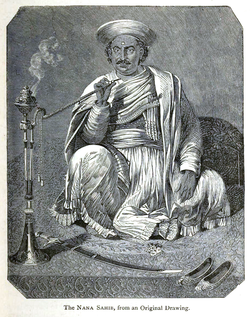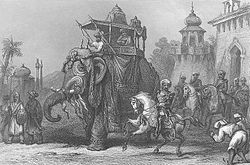
Nana Saheb Peshwa II
 | This article is currently undergoing a major edit by the . As a courtesy, please do not edit this page while this message is displayed. The copy editor who added this notice is listed in the page history. This page was last revised at 03:07, 29 September 2024 (UTC) (2 seconds ago) by SheriffIsInTown (talk · contribs) (). If you have any questions or concerns, please direct them to the . Thank you for your patience. |

Nana Saheb Peshwa II | |
|---|---|
 | |
| 14th Peshwa of the Maratha Empire (pretender) | |
| In office 1 February 1851 – 30 June 1857 (unrecognized) | |
| Preceded by | Baji Rao II |
| Peshwa from Kanpur | |
| In office 1 July – 16 July 1857 | |
| Personal details | |
| Born | Dhondu Pant 19 May 1824 Bithur, Cawnpore, Ceded Provinces, British India (present-day Bithoor, Kanpur Nagar district, Uttar Pradesh, India) |
| Died | 24 September 1859 (aged 35) (disputed) Kathmandu, Nepal |
| Parent(s) | Narayan Bhat (father) Ganga Bai (mother) |
| Relatives | Baji Rao II (adoptive father & uncle) |
Nana Saheb Peshwa II (19 May 1824 – after 1857), born Dhondu Pant, was an Indian aristocrat and fighter who led the Siege of Cawnpore (Kanpur) during the Indian Rebellion of 1857 against the East India Company. As the adopted son of the exiled Maratha Peshwa, Baji Rao II, Nana Saheb believed he was entitled to a pension from the Company. However, after being denied recognition under Lord Dalhousie's doctrine of lapse, he initiated a rebellion. He forced the British garrison in Kanpur to surrender and subsequently ordered the killing of the survivors, briefly gaining control of the city. After the British recaptured Kanpur, Nana Saheb disappeared, and conflicting accounts surround his later life and death.

Early life
Nana Saheb was born on 18 May 1824 as Nana Govind Dhondu Pant, to Narayan Bhat and Ganga Bai. After the Marathas were defeated in the Third Anglo-Maratha War, the East India Company exiled Peshwa Baji Rao II to Bithoor (near Kanpur), but allowed him to maintain a large establishment, partly funded by a British pension. Nana Saheb's father, a well-educated Deccani Brahmin, had travelled with his family from the Western Ghats to serve as a court official for the exiled Peshwa. He married the sister of one of the Peshwa's wives, with whom he had two sons.

As Baji Rao II had no biological sons, he adopted Nana Saheb and his younger brother, Bala Saheb, in 1827. Nana Saheb's childhood companions included Tatya Tope, Azimullah Khan, and Manikarnika Tambe. Tatya Tope, Nana Saheb's fencing master, was the son of Pandurang Rao Tope, a significant noble in the Peshwa's court who had accompanied his sovereign into exile. Azimullah Khan later became Nana Saheb's secretary and dewan.

Inheritance

At the time, the British East India Company had absolute, imperial administrative control over many regions across the subcontinent. The doctrine of lapse was an annexation policy devised by Lord Dalhousie, the British Governor-General of India between 1848 and 1856. According to this doctrine, any princely state or territory under the paramountcy of the Company would automatically be annexed if the ruler was either "manifestly incompetent" or died without a direct heir.[1] The doctrine overturned the long-established right of an Indian sovereign without an heir to select a successor, with the British reserving the power to decide the competency of potential rulers. The policy was widely resented by Indians as illegitimate.

Although the Peshwa's domains had been annexed in 1818, prior to the implementation of the doctrine, upon the death of Baji Rao II, the Company invoked the doctrine to deny Nana Saheb the pension previously granted, as he was an adopted son. Baji Rao had been provided an annual pension of 800,000 Rupees (£80,000 at the time), along with tax-free lands, but these provisions were rescinded after his death. Nana Saheb appealed for the restoration of the pension and funds, sending his advocate, Azimullah Khan, to London to plead his case.[2] However, the attempt was unsuccessful.

Nana Saheb was well-known to the British at Kanpur, as he often hosted parties for them. Sir Henry Lawrence and General Wheeler treated him with respect, and General Wheeler even invited him to take charge of the British treasury at Kanpur.[3]

Role in the 1857 uprising

At the start of the mutiny, Nana Saheb expressed loyalty to Company officials in Kanpur and even provided volunteers to protect the Europeans in the city.[4] It was planned that Nana Saheb would assemble a force of 1,500 soldiers to fight the rebels, in case the rebellion spread to Kanpur.[5]

On 6 June 1857, when the forces of the East India Company in Kanpur rebelled, the British contingent took refuge at an entrenchment in the northern part of the town. Amid the prevailing chaos, Nana and his forces entered the British magazine located in the northern part of the town. The soldiers of the 53rd Native Infantry, who were guarding the magazine, assumed that Nana had come to protect it on behalf of the Company. However, once inside, Nana Saheb declared his participation in the rebellion against the Company.[6]

After taking control of the Company treasury, Nana advanced along the Grand Trunk Road, declaring his intent to restore the Maratha confederacy under the Peshwa tradition. He decided to capture Kanpur and, along the way, encountered rebel Company soldiers at Kalyanpur. The soldiers were headed to Delhi to join Bahadur Shah II, but Nana persuaded them to return to Kanpur by promising to double their pay and reward them with gold if they helped him defeat the British. His eldest son Baan Rao was killed in the ensuing battle.

Attack on Wheeler's entrenchment

At the start of the mutiny, Nana Saheb professed loyalty to Company officials in Kanpur and even provided volunteers to protect Europeans in the city.[4] It was planned that Nana Saheb would assemble a force of 1,500 soldiers to fight the rebels in case the rebellion spread to Kanpur.[7]

On 6 June 1857, at the time of the rebellion by the East India Company forces at Kanpur, the British contingent had taken refuge at an entrenchment in the northern part of the town. Amid the prevailing chaos, Nana Saheb and his forces entered the British magazine in the northern part of Kanpur. The soldiers of the 53rd Native Infantry, guarding the magazine, believed Nana was there to protect it on behalf of the Company. However, once inside, Nana Saheb declared his participation in the rebellion against the Company.[6]

After taking control of the Company treasury, Nana moved up the Grand Trunk Road, declaring his intention to restore the Maratha Confederacy under the Peshwa tradition, with plans to capture Kanpur. On the way, he encountered rebel Company soldiers at Kalyanpur, who were headed to Delhi to meet Bahadur Shah II. Nana persuaded them to return to Kanpur and assist him in defeating the British by promising to double their pay and reward them with gold. In the subsequent battle, Nana Saheb's eldest son, Baan Rao, was killed.

The Company forces were unprepared for the attack. Wheeler’s wife, a distant relative of Nana Saheb, had asked Nana’s soldiers to guard the treasury. Instead of fortifying a magazine north of the depot with adequate arms and ammunition, the British barricaded themselves in two large, poorly fortified barrack buildings, one of masonry and another with a thatched roof, near the road to Allahabad. They had started constructing a masonry wall, but it was only four feet tall at the start of the conflict and was not bulletproof. Sixty years after the events, a large underground room was discovered at the barracks' site, which was unknown to both the British and Nana Saheb in 1857.[8]

The barracks housed around 900 Europeans, Eurasians, and Indians, of which only 210 were European soldiers, joined by around 100 armed civilians.[9] The British had five 9-pounders, one brass 3-pounder, and a mortar.[10] Initially, General Wheeler was confident enough to send part of his garrison to reinforce Lucknow. On 4 June, the Company sepoys of the 1st, 53rd, and 56th Native Infantry regiments and the 2nd Cavalry regiment rebelled, looted the treasury, and left Kanpur for Delhi. Nana Saheb, previously uncommitted, rushed up the Grand Trunk Road on his state elephant, enticed the rebels to serve him, and led them back to Kanpur on Azimulla Khan's advice.[11]

On 5 June 1857, Nana Saheb sent a letter to General Hugh Wheeler, informing him to expect an attack at 10 am the next day. On 6 June, his forces, including the rebel soldiers, attacked the Company entrenchment at 10:30 am. The British, caught off guard, defended themselves as the attackers hesitated to enter the entrenchment, fearing gunpowder-filled trenches. The British held out for three weeks with little water and food, losing many to sunstroke and dehydration. On 7 June, the rebels brought large calibre guns, and the bombardment of the entrenchment began.[12]

As Nana Saheb's advances over the British garrison became known, more rebel sepoys joined him. By 10 June, Nana led around 12,000 to 15,000 Indian soldiers.[13] The first week of the siege saw Nana's forces establish firing positions from nearby buildings. Captain John Moore of the defending forces launched retaliatory night sorties. Nana Saheb then withdrew his headquarters to Savada House, two miles away. On 13 June, the rebels set fire to one of the thatched barracks used as a hospital, but their charge was repelled by British grape shot.[14]

Sniper fire and bombardment continued until 23 June. A prophecy about the downfall of East India Company rule exactly 100 years after the Battle of Plassey motivated over 4,000 rebel soldiers to launch a major attack on 23 June, beginning with a cavalry charge. General Wheeler waited until the cavalry was 50 yards away before opening fire with grape shot.[15] The infantry, using cotton bales for cover, approached within 100 yards of the perimeter but failed to breach the entrenchment. On the same day, a 9-pound shot decapitated Gordon Wheeler, General Wheeler's son.[16]

Meanwhile, in the city, those associated with the British were killed, and sectarian violence erupted, partly inflamed by Baba Bhatt, Nana's elder brother. The situation was defused to some extent by Azimulla Khan. On 25 June, a Eurasian prisoner named Mrs Jacobi approached the entrenchment with an offer of honourable surrender and safe passage to Allahabad.[17] Facing dwindling provisions and no reinforcements, Wheeler accepted the offer on 26 June, leading to a truce and negotiations with Azimulla Khan and Jawala Prasad, commander of Nana’s cavalry. The garrison would be allowed to march out with their side arms and ammunition but had to leave the artillery behind.

Satichaura Ghat massacre


On the morning of 27 June, Wheeler's column, consisting primarily of unarmed civilians, including more than 300 women and children, emerged from the entrenchment. Nana sent a number of carts, dolis, and elephants to enable the women, children, and sick to proceed to the riverbanks. The Company officers and military men were allowed to take their arms and ammunition with them and were escorted by nearly the entire rebel army.[13] They reached the Satichaura Ghat by 8 am. At this ghat, Nana Saheb had arranged around 40 boats, belonging to a boatman named Hardev Mallah, for their departure to Allahabad.[18]

However, Nana Saheb's rebels had deliberately placed the boats as high in the mud as possible to delay the boarding, making it difficult for the Europeans to drift the boats away.[19] Wheeler and his party were the first aboard and managed to set their boat adrift. At this point, three shots were fired from the direction of Nana Saheb's camp, signaling the start of the attack. The Indian boatmen jumped overboard and began swimming toward the banks.[citation needed] However, according to Mowbray Thompson, one of the few survivors of the massacre, before the boatmen jumped overboard, they had "contrived to secrete burning charcoal in the thatch of most of the boats," which set some of the boats ablaze.[20] Though there is controversy surrounding what exactly happened next at the Satichaura Ghat, the departing Europeans were attacked by the rebel sepoys, and most were either killed or captured.[13]

Some of the Company officers later claimed that Nana had intentionally placed the boats high in the mud to cause delays. They also claimed that Nana had previously arranged for the rebels to fire upon and kill all the Europeans.[citation needed] Although the East India Company later accused Nana of betrayal and murder of innocent people, no definitive evidence has ever been found to prove that Nana had pre-planned or ordered the massacre.[21] Some historians believe that the Satichaura Ghat massacre was the result of confusion rather than a plan implemented by Nana and his associates.[22] Nevertheless, reports of sniper fire from cannons pre-positioned along the riverbank might suggest pre-planning.

Amid the prevailing confusion at the Satichaura Ghat, Nana's general, Tatya Tope, allegedly ordered the 2nd Bengal Cavalry unit and some artillery units to open fire on the Europeans.[6] The rebel cavalry sowars moved into the water to kill the remaining Company soldiers with swords and pistols. The surviving men were killed, while women and children were captured, as Nana did not approve of their killing.[23] Around 120 women and children were taken prisoner and escorted to Savada House, Nana Saheb's headquarters during the siege. Two ladies, Mrs. Lett and Mrs. Bradshaw, hid among the grass, disguised themselves, and escaped at night.[24] One boat also escaped, and the boaters found refuge with Raja Dirigibijah Singh, who protected them and later had them escorted to the British lines.[25]

The rebel soldiers pursued Wheeler's boat, which was slowly drifting to safer waters. After some firing, the European men on the boat decided to fly the white flag. They were escorted off the boat and taken back to Savada House. The surviving men were seated on the ground as Nana's soldiers prepared to kill them. The women insisted they would die with their husbands but were pulled away. Nana granted the British chaplain Rev. Cockey's request to read prayers before they were killed.[26][27] The British were initially wounded by gunfire and then killed with swords.[13] The women and children were taken to Savada House to be reunited with their remaining colleagues.

Bibighar massacre
On the advice of astrologers, Nana was consecrated as Baji Rao's heir on 1 July amid much fanfare and a 21-gun salute.[28] Meanwhile, the surviving women and children, along with their Indian supporters—around 120 in number—were moved from Savada House to Bibighar ("the House of the Ladies"), a villa-type house in Kanpur. They were later joined by other women and children, the survivors from Wheeler's boat. Another group of women and children from Fatehgarh, as well as some other captive women, were also confined in Bibighar. In total, there were around 200 women and children there. An Indian ayurvedic doctor was allowed to attend to the captives and recorded thirty-six fatalities (18 British women, 17 children, and 1 Hindu nurse), possibly due to cholera, in the first week of their capture. Following this, the captives were allowed out of the building twice a day under guard.[29] In the meantime, Nana's army had swelled to over 20,000, and the billeting of these troops caused unhappiness among the citizens of Kanpur; sectarian tensions were increasing as well.[30]

Nana Saheb deputed a tawaif (nautch girl) named Hussaini Khanum (also known as Hussaini Begum) to care for the survivors. He decided to use these prisoners as leverage in bargaining with the East India Company. On 9 July, Nana received news that a company of 700 under the command of Major Sydenham Renaud was advancing along the Grand Trunk Road, indiscriminately punishing Indian villages en route.[31] Further Company forces, consisting of around 1,200 British soldiers, 150 Sikh soldiers, 30 irregular cavalry, and 6 cannons, had set out from Allahabad under the command of General Henry Havelock to retake Cawnpore and Lucknow. Havelock's forces were later joined by those under Major Renaud and James Neil. Nana demanded that the East India Company forces under Havelock and Neil retreat to Allahabad. However, the Company forces advanced relentlessly towards Cawnpore. Nana sent an army to check the advance of Major Renaud's forces, but they encountered General Havelock's army at Futtehpore on 12 July. The rebels had no answer to the British artillery and the Enfield rifles, which had an accurate range of 900 yards. Tatya Tope had an elephant shot under him by cannon, and General Havelock's forces emerged victorious, capturing the town with few casualties.

Nana then sent another force under the command of his brother, Bala Rao. On 15 July, Bala fortified his positions at Aong behind walled gardens, with two cannons covering the route of the British. The British mounted patrol was aware of this, leading to the Battle of Aong. Major Renaud charged at the head of his forces, was wounded in the thigh, and later succumbed to his injuries.[32] The British artillery cleared the rebel artillery, forcing Bala to retreat beyond the Pandu River and secure the stone bridge across it. Sympathetic Indian villagers informed Havelock of this, and he marched his forces 16 miles under the sun, flanking the bridge from the village of Maharajpore.[33] In the meantime, Nana Sahib had arrived with more artillery to bolster his forces. The British advanced under heavy fire, with Havelock's son, Harry Marsham Havelock, driving his horse against the muzzle of a cannon just before it fired, thereby saving his company. He was awarded the Victoria Cross for this act. The British infantry charged, seized the lines, and Nana fled the field, leaving two cannons behind.[34] On 16 July, Havelock's forces began advancing towards Bithur. They managed to rescue a prisoner from the siege, William Jonah Shepherd,[35] who provided them with valuable information.

Nana Sahib and his associates, including Tatya Tope and Azimullah Khan, debated what to do with the four men and 206 women and children held at Bibighar. Some of Nana Sahib's advisors had already decided to kill the captives at Bibighar as revenge for the executions of Indians by the advancing British forces. Azimullah Khan suggested that the British might turn back from Kanpur if they had no hostages to rescue.[36][37] The women of Nana Sahib's household opposed this decision and went on a hunger strike, but their efforts were in vain.[38][37]

On the 15th, after Bala arrived and announced his defeat at the Pandu River, the four male captives—Mr Thornhill, a judge from Fatehgarh; Col. Smith; Col. Goldie; and the 14-year-old Greenway—were bound, brought out of Bibighar, and shot by the sepoys.[37]

Within an hour, Hussaini Begum announced to the women that they too would be killed. Jemadar Yousef Khan and his sepoys refused to kill the prisoners, even disobeying the orders of Tatya Tope on the matter.[39] That evening, Hussaini Khanum organised four butchers from the Kanpur market, as well as a Eurasian member of Nana's personal bodyguard, to kill the prisoners, and during the course of the night, the entire group of prisoners was massacred. The screams were heard by the citizens who lived nearby.[39] The next morning, the five returned with sweepers to remove the bodies. The bodies of the dead and three severely wounded boys were thrown into a well 9 feet wide and 50 feet deep near the house.[40][41]

Recapture of Kanpur by the British

The Company forces reached Kanpur on 16 July 1857. Upon hearing of their approach and the news of the massacre, the local population fled.[41] In the early hours of Friday, 17 July, the British arrived at Wheeler's encampment. Two sympathetic Indians informed Havelock about the massacre at Bibighar[42] and that Nana Sahib had taken a position at Ahirwa village. The British forces launched an attack on Nana's troops and emerged victorious. In response, Nana blew up the Kanpur magazine, abandoned the location, and retreated to Bithur.

The women and children imprisoned in Bibighar had already been massacred with appalling violence. When the British soldiers, particularly Colonel Neill, learned of the Bibighar massacre, they engaged in retaliatory violence, including looting and burning houses.[6][43] Neill forced the captured rebels to clean up the blood in Bibighar before executing them.[44] On 18 July, Havelock heard about Neill's punishments and put an end to the indiscriminate killing, even hanging one British soldier for his actions.[45]


On 19 July, General Havelock resumed operations and left Bithur to save Lucknow, leaving Neill in charge at Kanpur. Nana Sahib had already escaped with an army of 12,000. Major Stevenson led a group of Madras Fusiliers and Sikh soldiers to Bithur, occupying Nana Sahib's palace without resistance.[46][47] Very few relics of Nana Saheb are known, but a silver-mounted sword seems to be one of the more interesting artifacts. Many British search parties attempted to capture Nana Saheb but failed. A detachment of the 7th Bengal Infantry came very close to capturing him, but he managed to escape just in time, leaving this sword on the table where he had been dining. Major Templer (later Major General) of the 7th Bengal Infantry brought the sword home. In the 1920s, the family loaned it to the Exeter Museum, until it was sold at auction in 1992. The present whereabouts of this sword are unknown.

By 13 August, around 4,000 rebels had reoccupied Bithur and threatened Havelock's lines of communication at Bashiratganj. They were chased from their positions and regrouped at Bithur, where they were joined by the experienced Gwalior contingent and sepoys of the 42nd Infantry. The Madras Fusiliers, Highlanders, and Sikhs charged the defenders, forcing them to retreat and capturing their artillery. Havelock's forces suffered over 50 battle casualties and 12 from heat stroke, but the rebels were driven out of Bithur. After leaving a small force in Kanpur, General Havelock marched to Lucknow, where he broke through the lines but was besieged in the residency on 25 September, ultimately succumbing to dysentery.[48]

Sir Colin Campbell was then put in charge of the British forces in the area. Kanpur remained peaceful due to the British garrison, with scant news about Nana Sahib. Rumours suggested he was attempting to link up with Tatiya Tope at Fatehpur Chaurasi or was in Chandemagore seeking French assistance.[49] Campbell left for Lucknow on 9 November, leaving behind a garrison of 500 British and Sikh soldiers under the command of the inexperienced Major General Windham.[50] Tatiya Tope's counterintelligence unmasked the Indian spies working for the British; they were mutilated and sent back to the British lines as a warning.[51]

Tatiya Tope attempted to recapture Kanpur during the Second Battle of Cawnpore in November 1857. He arrived with 6,000 soldiers and 18 cannon, with increasing numbers of volunteers and stragglers joining him. On 24 November, Windham advanced, intending to chase Tope, but the British lost the ensuing battle and withdrew to the newly fortified barracks. By 27 November, Kanpur was back in the hands of the Peshwa, and the bombardment of the British lines began. Wounded British officers left in the field were hanged from the branches of the very banyan tree where Neill had previously hung suspected rebels.[52] Tatiya Tope managed to take control of all the routes west and northwest of Kanpur.

Bala Rao, Jwala Prasad, and Rao Sahib set up their headquarters in the European quarter of Kanpur, though it remains unclear whether Nana Sahib and Azimulla Khan were with them. In the meantime, Sir Colin Campbell retrieved the British forces from Lucknow and transported them to Allahabad. By 5 December, he had reached Kanpur with his men. Tatiya Tope's army had also been reinforced and now included over 14,000 men, including the Gwalior contingent and 40 cannon.[53] On 6 December, the British commenced an artillery barrage, and General Mansfield attacked the left flank of the rebel army, defeating them.[53] On 7 December, the British reached the Bithur palace. The Nana had fled just prior to the arrival of the British cavalry, taking much of his treasure with him; however, he left behind treasure worth millions of rupees, along with guns, elephants, silver howdahs, and camels, all of which were seized by the British. Following extensive excavations to retrieve any hidden treasure, they set Nana Sahib's palace on fire.[54]

Disappearance
Nana disappeared from Bithur after the company's recapture of Kanpur. The British offered a reward of Rs 100,000 (£10,000) for his capture. Subsequently, his movements could not be confirmed, as he consistently stayed a step ahead of his would-be captors. On 10 February 1858, Nana was reported to have entered Bundelkhand.[55] Anghad Tiwari, a capable intelligence officer of the British, tracked him to a small fort in Fatehpur Chaurasi on 17 February, but he escaped just prior to the arrival of the British cavalry.

At the start of April, the British learned that Nana had crossed the river near Bithur with an escort of 500 cavalry; however, he evaded the patrols sent by General Hope Grant to apprehend him. By the end of April, Nana had retreated back to Shahjahanpur. On 29 April, he wrote a letter addressed to Queen Victoria, stating that he had committed no murders and that the killings were carried out by rebels or *budmashes*.[56] In the meantime, Bala wrote a letter blaming his brother for the situation, claiming his own innocence.[57]

In September 1857, Nana was reported to have fallen victim to malarial fever; however, this is disputed.[58] He had also previously pretended to commit suicide at the Ganges, suggesting he might have been trying to cover his tracks.[59] Rani Laxmibai, Tatya Tope, and Rao Saheb (Nana Saheb's close confidante) proclaimed Nana Saheb as their Peshwa in June 1858 at Gwalior. In December, both Nana and the Begum of Oudh were said to be in Bahraich.[60]

On 30 December 1858, the British won the Battle of Banki. Although many rebels surrendered, it was understood that Nana and his brother forded the river into Nepal with eight elephants loaded with treasure when the fight began.[61] Both the rebels and the pursuing British suffered casualties during the river crossing.[62]

Nepal connection
By 1859, Nana was reported to have fled to Nepal.[63] Letters purportedly written by Bala and Nana, asking for terms of surrender, were sent to the British from Nepal.[64] Perceval Landon recorded that Nana Sahib lived out his days in western Nepal, in Thapa Teli near Ririthang, under the protection of Sir Jang Bahadur Rana, the Prime Minister of Nepal. The final confirmed letter written by Nana, stamped with his own seal, was from 13 May the following year.[65] His family also received protection in Dhangara, eastern Nepal, in exchange for precious jewels.[66] In February 1860, the British were informed that Nana's wives had taken refuge in Nepal, residing in a house close to Thapathali. Nana himself was reported to be living in the interior of Nepal, as he did not trust the Rana.[67] Thereafter, Nana disappeared from recorded history.

In October 1860, the British resident in Kathmandu was informed that Nana had passed away on 24 September due to malaria.[65] Some government records claimed he died in Nepal after being attacked by a tiger during a hunt on 24 September 1859, though there are conflicting accounts.[68] Nana's ultimate fate was never confirmed, and Bala was also said to have died of fever in the jungles of Nepal.[57]

Venkateshwar, a Brahmin interrogated by the British, disclosed that he met Nana Sahib in Nepal in 1861.[68] Up until 1888, there were rumours and reports that he had been captured, with several individuals claiming to be the aged Nana turning themselves in to the British. As these reports proved false, further attempts at apprehending him were abandoned. There were also reports of him being spotted in Constantinople (now Istanbul).[citation needed]

Sihor connection
Two letters and a diary retrieved in the 1970s suggest that Nana Saheb lived as an ascetic, Yogindra Dayanand Maharaj, in Sihor in coastal Gujarat until his death in 1903.[citation needed] The letters, possibly written by Nana Saheb in Old Marathi and signed Baloo Nana, were addressed to Harshram Mehta, Nana's Sanskrit teacher. The third document, the diary of Kalyanji Mehta, Harshram's brother,[citation needed] is written in Old Gujarati. The diary records Nana Saheb's arrival in Sihor with his colleagues after the failure of the rebellion. Kalyanji raised Shridhar, Nana Saheb's son, under the name Giridhar, and arranged his marriage into a Sihori Brahmin family. The diary also notes Nana Saheb's death in 1903 at Kalyanji's house in Dave Sheri, Sihor, where some of Nana's belongings are still preserved. These documents were recovered by Keshavlal Mehta, Giridhar's son, in the 1970s, and his descendants continue to reside in the town.[68]

The authenticity of these documents was accepted by G.N. Pant, former director of the National Museum, in 1992, but they have not received official recognition.[68]

Belsare's account
K. V. Belsare's book on the Maharashtrian saint Brahmachaitanya Gondavlekar Maharaj claims that after the lost battle, Nana Saheb went to Naimisharanya, the Naimisha Forest near Sitapur, Uttar Pradesh, where he met Brahmachaitanya Maharaj, who assured him of safety. Nana Saheb is said to have lived there from 1860 until his death in 1906. According to the book, he died between 30 October and 1 November 1906, and Shri Brahmachaitanya Maharaj performed his last rites.[69] The authenticity of the claims in the book is not established.[citation needed]

Initially, Nana Saheb was deeply distressed by the loss of his kingdom in battle with the British. However, Shri Gondavalekar Maharaj explained to him the "Wish of God." He said, "It is very sad that Nana Saheb had to lose the battle and the kingdom in such a tragic way, but fighting the British is totally different from fighting the Mughals. People from the middle class, who understand the British language, will lead the next freedom war against the British. Soon they will come into the picture. Your role as a king or warrior has ended, and now you need to focus on the 'internal war'." Although it was initially difficult for Nana Saheb to accept this, he gradually came to terms with it and made progress on his spiritual journey.[70]

Aftermath
Jwala Prasad, Nana's brigadier, was apprehended and hanged in Kanpur. Before his execution, he claimed to have been present at Nana's cremation in Nepal.[71] Tatia Tope, Nana's commander, was betrayed in April 1859 by Man Singh, the Raja of Narwar, who handed him over to the British. On the 18th of April, he was executed. Rao Sahib, too, was betrayed and handed over to the British in 1862. He was hanged at Satichaura Ghat on the 20th of August.[55]

Hussaini Begum is believed to have fled with Nana's entourage to Nepal, where she disappeared from history. However, Sarvur Khan, the bodyguard she had employed to carry out the massacre at Bibighar, was arrested in February 1858 along with Muhammed Ali Khan, a courtier who had travelled to England in the entourage of Azimullah Khan. Owing to the courteous treatment by British officer Forbes-Mitchell up to their execution, Muhammed Ali Khan provided more information about the events. He blamed Hussaini Begum for the Bibighar massacre, stating that she harboured grievances against the British and took them out on the hapless captives.[72]

Baba Bhutt and Azimullah Khan were reportedly seen near Kolkata, but their fate remains uncertain. Azimullah is said to have died of smallpox in Bengal. Alternatively, there are claims that he escaped to Istanbul with an English lady, Miss Clayton, where they lived until old age. According to this account, Khan was murdered in Istanbul after Miss Clayton's death of old age.[73]

General James Neill was killed in action during the relief of Lucknow on 25 September 1857. Major General Sir Henry Havelock died of dysentery in Lucknow in November 1857, shortly after the garrison had been rescued. Sir James Outram died in March 1863 in France, while Sir Colin Campbell, later ennobled as Baron Clyde, died in August 1863 in Kent.[73]

After India gained independence in 1947, Nana was hailed as a freedom fighter, and the Nana Rao Park in Kanpur was constructed in honour of him and his brother, Bala Rao.

In popular culture
- Nana Sahib, a drama in verse by Jean Richepin with incidental music by Jules Massenet, opened on 20 December 1883 at the Théâtre de la Porte Saint-Martin in Paris.[74]
- Nana Sahib (based on Captain Nemo) is the principal character of the 1975 Soviet film Captain Nemo, his role is played by Vladislav Dvorzhetsky. He is also seen in Age of Empires III: The Asian Dynasties as Nanib Sahir.[citation needed]
- Jules Verne's novel The End of Nana Saheb (also published under the name "The Steam House"), taking place in India ten years after the 1857 events, is based on these rumours, and not historically accurate – for example, the novel claims Nana Saheb had been married to Rani Lakshmibai of Jhansi.[citation needed]
- In The Devil's Wind, Manohar Malgonkar gives a sympathetic reconstruction of Nana Saheb's life before, during and after the mutiny as told in his own words.[75]
- Another novel Recalcitrance published in 2008 the 150th anniversary year of the Indian Rebellion of 1857 and written by Anurag Kumar shows a character similar to Sahib receiving blessings from an Indian sage who also gives him a special boon connected to his life and the rebellion of 1857.[citation needed]
- The character of Surat Khan in the 1936 film The Charge of the Light Brigade seems to be loosely based on Nana Saheb.[citation needed]
- A novel by Donald Cirulli titled The Devil's Wind was published in 2018 described, among other things, the siege of Wheeler's Entrenchment at Cawnpore and the British attack of Delhi (both in 1857).[citation needed]
- The character of Nana Saheb is portrayed by Bhupinder Singh in the DD National TV series 1857 Kranti.[citation needed]
- In Bharat Ek Khoj character of Nana Saheb was portrayed Anang Desai.[citation needed]
- In Satyajit Ray's Feluda novel Bombaiyer Bombete, a necklace belonging to Nana Saheb from Kathmandu is smuggled into India.[citation needed]
See also
References
- ^ Keay, John. India: A History. New York: Grove Press Books, distributed by Publishers Group West. 2000 ISBN 0-8021-3797-0, p. 433.
- ^ Cawnpore and Lucknow, Richards DS, 2007, ISBN 1-84415-516-1, pp 28
- ^ Cawnpore and Lucknow, Richards DS, 2007, ISBN 1-84415-516-1, pp 29
- ^ a b "British Empire: Forces: Campaigns: Indian Mutiny, 1857 – 58: The Siege of Cawnpore". britishempire.co.uk. Retrieved 6 April 2015.
- ^ Brock, William (1857). A Biographical Sketch of Sir Henry Havelock, K. C. B. Tauchnitz. Retrieved 12 July 2007.
- ^ a b c d "The Indian Mutiny: The Siege of Cawnpore". Retrieved 11 July 2007. Cite error: The named reference "britishempire_cawnpore" was defined multiple times with different content (see the help page).
- ^ Brock, William (1857). A Biographical Sketch of Sir Henry Havelock, K. C. B. Tauchnitz. Retrieved 12 July 2007.
- ^ Red year, M Edwardes, 1973, ISBN 0351159975, page 70
- ^ Cawnpore and Lucknow, DS Roberts, 2007, ISBN 1-84415-516-1, pp 40
- ^ Cawnpore and Lucknow, DS Roberts, 2007, ISBN 1-84415-516-1, pp 38
- ^ Cawnpore and Lucknow, DS Roberts, 2007, ISBN 1-84415-516-1, pp 37
- ^ Cawnpore and Lucknow, DS Roberts, 2007, ISBN 1-84415-516-1, pp 42
- ^ a b c d Wright, Caleb (1863). Historic Incidents and Life in India. J. A. Brainerd. p. 241. ISBN 978-1-135-72312-5.
- ^ Cawnpore and Lucknow, DS Roberts, 2007, ISBN 1-84415-516-1, pp 48
- ^ Cawnpore and Lucknow, DS Roberts, 2007, ISBN 1-84415-516-1, pp 57
- ^ Cawnpore and Lucknow, DS Roberts, 2007, ISBN 1-84415-516-1, pp 58
- ^ Cawnpore and Lucknow, DS Roberts, 2007, ISBN 1-84415-516-1, pp 60
- ^ "Echoes of a Distant War". The Financial Express. 8 April 2007. Archived from the original on 21 January 2008. Retrieved 11 July 2007.
{{cite web}}: CS1 maint: bot: original URL status unknown (link) - ^ Wright, C. & J. A. Brainerd (1863). Historic Incidents and Life in India. p. 241.
- ^ Thompson, Mowbray (1859). The Cawnpore Man. Leonaur. p. 93. ISBN 978-1-84677-573-4.
- ^ Hibbert, Christopher (1978). The Great Mutiny: India, 1857. Viking Press. pp. 194. ISBN 0-670-34983-6.
- ^ Nayar, Pramod K. (2007). The Great Uprising. Penguin Books, India. ISBN 978-0-14-310238-0.
- ^ G. W. Williams, "Memorandum", printed with Narrative of the Events in the NWP in 1857–58 (Calcutta, n.d.), section on Cawnpore (hereafter Narrative Kanpur), p. 20: "A man of great influence in the city, and a government official, has related a circumstance that is strange, if true, viz. that whilst the massacre was being carried on at the ghat, a trooper of the 2nd Cavalry reported to the Nana, then at Savada House, that his enemies, their wives, and children were exterminated ... On hearing which, the Nana replied that for the destruction of women and children, there was no necessity' and directed the sowar to return with an order to stay their slaughter." See also J. W. Kaye, History of the Sepoy War in India, 1857–58, 3 vols. (Westport, 1971 repr.), ii, p. 258. (This reprint of Kaye's work carries the title History of the Indian Mutiny of 1857–58.)
- ^ Cawnpore and Lucknow, DS Roberts, 2007, ISBN 1-84415-516-1, pp 68
- ^ Cawnpore and Lucknow, DS Roberts, 2007, ISBN 1-84415-516-1, pp 77
- ^ Cawnpore and Lucknow, DS Roberts, 2007, ISBN 1-84415-516-1, pp 75
- ^ Brock, William (1858). A Biographical Sketch of Sir Henry Havelock, K. C. B. Tauchnitz. pp. 150–152. Retrieved 12 July 2007.
- ^ Cawnpore and Lucknow, DS Roberts, 2007, ISBN 1-84415-516-1, pp 80
- ^ Cawnpore and Lucknow, DS Roberts, 2007, ISBN 1-84415-516-1, pp 81
- ^ Cawnpore and Lucknow, DS Roberts, 2007, ISBN 1-84415-516-1, pp 82
- ^ Cawnpore and Lucknow, DS Roberts, 2007, ISBN 1-84415-516-1, pp 83
- ^ Cawnpore and Lucknow, DS Roberts, 2007, ISBN 1-84415-516-1, pp 8
- ^ Cawnpore and Lucknow, DS Roberts, 2007, ISBN 1-84415-516-1, pp 88
- ^ Cawnpore and Lucknow, DS Roberts, 2007, ISBN 1-84415-516-1, pp 90
- ^ Cawnpore and Lucknow, DS Roberts, 2007, ISBN 1-84415-516-1, pp 91
- ^ Red Year, M. Edwardes, 1973, ISBN 0351159975, page 73
- ^ a b c Cawnpore and Lucknow, DS Roberts, 2007, ISBN 1-84415-516-1, pp 92
- ^ V. S. "Amod" Saxena (17 February 2003). "Revolt and Revenge; a Double Tragedy (delivered to The Chicago Literary Club)". Archived from the original on 5 August 2007. Retrieved 11 July 2007.
- ^ a b Cawnpore and Lucknow, DS Roberts, 2007, ISBN 1-84415-516-1, pp 93
- ^ Red year, M Edwardes, 1973, ISBN 0351159975, page 74
- ^ a b Cawnpore and Lucknow, DS Roberts, 2007, ISBN 1-84415-516-1, pp 94
- ^ Cawnpore and Lucknow, DS Roberts, 2007, ISBN 1-84415-516-1, pp 97
- ^ "India Rising: Horrors & Atrocities". National Army Museum, Chelsea. Archived from the original on 18 July 2007. Retrieved 11 July 2007.
- ^ Cawnpore and Lucknow, DS Roberts, 2007, ISBN 1-84415-516-1, pp 100
- ^ Cawnpore and Lucknow, DS Roberts, 2007, ISBN 1-84415-516-1, pp 101
- ^ Pratul Chandra Gupta (1963). Nana Sahib and the Rising at Cawnpore. Clarendon Press. p. 145. OCLC 1077615.
- ^ :Indian War of Independence by Savarkar, http://savarkar.org/en/encyc/2017/5/22/2_03_34_24_the_indian_war_of_independence_1857_with_publishers_note.v001.pdf_1.pdf
- ^ Battles of the Indian Mutiny, Edwardes M, 1963, ISBN 0 300 02524 4
- ^ Cawnpore and Lucknow, DS Roberts, 2007, ISBN 1-84415-516-1, pp 109
- ^ Battles of the Indian Mutiny, Edwardes M, 1963, ISBN 0 300 02524 4, pp 115
- ^ Cawnpore and Lucknow, DS Roberts, 2007, ISBN 1-84415-516-1, pp 115
- ^ Cawnpore and Lucknow, DS Roberts, 2007, ISBN 1-84415-516-1, pp 118
- ^ a b Battles of the Indian Mutiny, Edwardes M, 1963, ISBN 0 300 02524 4, pp 118
- ^ Cawnpore and Lucknow, DS Roberts, 2007, ISBN 1-84415-516-1, pp 108
- ^ a b Cawnpore and Lucknow, DS Roberts, 2007, ISBN 1-84415-516-1, pp 189
- ^ Cawnpore and Lucknow, DS Roberts, 2007, ISBN 1-84415-516-1, pp 190
- ^ a b The Indian Mutiny, David S, 2002, Penguin books
- ^ "The South Australian Advertiser, Monday 12 March 1860". South Australian Advertiser. 12 March 1860. Retrieved 4 March 2010.
- ^ The Great Indian Mutiny, Hibbert C, 1978, Penguin books
- ^ Cawnpore and Lucknow, DS Roberts, 2007, ISBN 1-84415-516-1, pp 191
- ^ Red year, M Edwardes, 1973, ISBN 0351159975, page 76
- ^ Cawnpore and Lucknow, DS Roberts, 2007, ISBN 1-84415-516-1, pp 193
- ^ Letter, The Times, (London), 28 December 1860.
- ^ Red year, M Edwardes, 1973, ISBN 0351159975, page 77
- ^ a b Cawnpore and Lucknow, DS Roberts, 2007, ISBN 1-84415-516-1, pp 194
- ^ [Perceval Landon, "The Later Days of Nana Sahib", Under the Sun. New York, Doubleday, Page & Co. (1907), pp. 272–288.]
- ^ Wright, Daniel (1993). History of Nepal: With an Introductory Sketch of the Country and People of Nepal. Asian Educational Services. p. 64. ISBN 81-206-0552-7.
- ^ a b c d "1857 revolt hero Nanasaheb Peshwa's life remains a mystery". India Today. 26 January 2004. Retrieved 15 January 2015.
- ^ K.V.Belsare, Brahmachaitanya Shri Gondavalekar Maharaj – Charitra & Vangmay
- ^ Belsare, Keshav Vishnu (1931). Brahmachaitanya Shri Gondavalekar Maharaj – Charitra & Vaagmay (in Marathi). KV Belsare.
- ^ Cawnpore and Lucknow, DS Roberts, 2007, ISBN 1-84415-516-1, pp 196
- ^ Cawnpore and Lucknow, DS Roberts, 2007, ISBN 1-84415-516-1, pp 197
- ^ a b Cawnpore and Lucknow, DS Roberts, 2007, ISBN 1-84415-516-1, pp 198
- ^ Demar Irvine (1994). Massenet: A Chronicle of His Life and Times. Amadeus Press. ISBN 1-57467-024-7.
- ^ Manohar Malgonkar (1972). The Devil's Wind. Hamish Hamilton. ISBN 0-241-02176-6.
Further reading
- Gupta, Pratul Chandra (1963). Nana Sahib and the Rising at Cawnpore. Oxford University Press. ISBN 0-19-821523-1.
- Shastitko, Petr Mikhaĭlovich; Savitri Shahani (1980). Nana Sahib: An Account of the People's Revolt in India, 1857–1859. Shubhada-Saraswat Publications.
See what we do next...
OR
By submitting your email or phone number, you're giving mschf permission to send you email and/or recurring marketing texts. Data rates may apply. Text stop to cancel, help for help.
Success: You're subscribed now !
